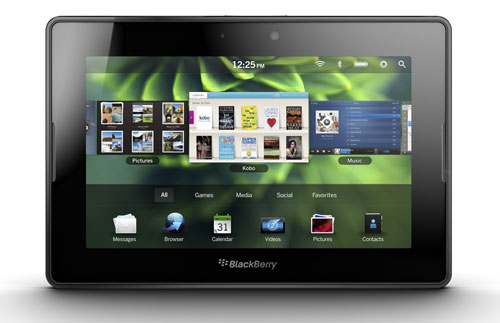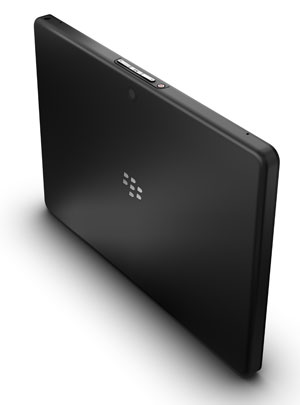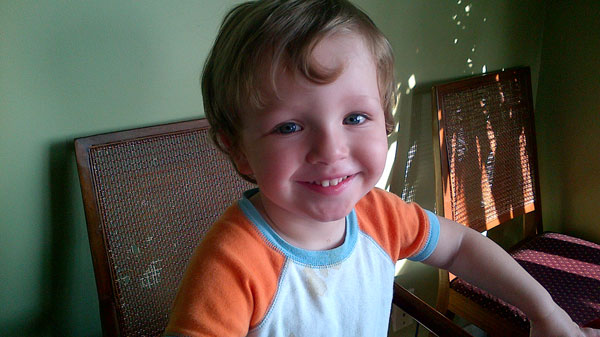We may earn commissions when you buy from links on our site. Why you can trust us.
BlackBerry PlayBook Review - How Does it Stack up?
The BlackBerry PlayBook is finally here. Does it have what it takes to compete against the iPad 2 and the wave of Android tablets coming to market?
In my review, the short answer is "no," at least not now. There's just too much core functionality missing, including the ability to manage your email, calendar on contacts on the device, and a very weak app market. Which is too bad, because the device itself is solid in other respects.
 Executives from PlayBook maker RIM promise email support and Android app capabilities in future releases, and that would make the PlayBook a more competitive product. But the tech world is littered with promises never delivered. And in today's market, even most BlackBerry faithful would be better served by the iPad.
Executives from PlayBook maker RIM promise email support and Android app capabilities in future releases, and that would make the PlayBook a more competitive product. But the tech world is littered with promises never delivered. And in today's market, even most BlackBerry faithful would be better served by the iPad.
How it feels in the hand
As a device meant for portability, the 7" PlayBook is a much better size than the 9.7" iPad 2 or the 10.1" Motorola Xoom. It can fit easily into a small bag or suit jacket pocket, and weighs six ounces less than an iPad 2 (0.9 lbs versus 1.33 lbs).
The BlackBerry PlayBook is also very comfortable to hold. The small size and light weight make it more akin to a Kindle than an iPad, and the rubberized back avoids the iPad's slippery tendencies.
 One letdown of the PlayBook case is the power button. It's a tiny dot that is inset flush with the top of the device, making it nearly impossible to press without a fair amount of focus and, preferably, a long finger nail.
One letdown of the PlayBook case is the power button. It's a tiny dot that is inset flush with the top of the device, making it nearly impossible to press without a fair amount of focus and, preferably, a long finger nail.
To protect it while traveling, the PlayBook comes with a neoprene sleeve.
Display and sound
The BlackBerry PlayBook's display is reasonably bright, with rich colors. It actually offers the same 1024x600 resolution as the Apple iPad 2, even though it's only 7", which provides for sharp text and plenty of detail in images. There is also and HDMI-out so you can display the PlayBook's movies on your big screen TV in full 1080p.
Audio from the PlayBook's stereo speakers was loud and had pretty impressive audio quality for a device this size. You're not going to be rocking the house, but will more than serve the needs of an ad hoc demo or a movie for the kids.
Web browsing
With a dual core processor and full Flash capabilities, the BlackBerry PlayBook browser comes close to equaling the desktop experience. The PlayBook supports tabbed browsing, though switching between open windows requires two steps—similar to the iPad, but not as convenient as the row of open tabs on the Motorola Xoom.
The PlayBook only comes in a Wi-Fi version. RIM say that 3G/4G models will be coming this summer.
Camera and video recording
Tablets are usually too big to be useful as cameras, but at 7", the PlayBook isn't terrible. And the built-in 5MP rear-facing and 3MP front-facing cameras are actually quite good, especially when compared to the iPad 2's horrendous .69 MP rear-facing camera and .33 MP camera in front.
Photos from the PlayBook had accurate colors and proper saturation. The PlayBook isn't great in low light situations, with the graininess typical of devices that aren't really cameras but trying to be, and there is no built-in flash.
 The rear camera can also shoot 1080p video. Again, results were much better with proper lighting but better than I expected from a tablet.
The rear camera can also shoot 1080p video. Again, results were much better with proper lighting but better than I expected from a tablet.
The front-facing camera is perfect for video chat except for the slight problem that there is no video chat app available for the PlayBook yet. Surprising given BlackBerry's business underpinnings and the huge benefit video conferencing would offer.
Keyboard & Navigation
Navigation on the BlackBerry PlayBook is intuitive and well thought out. The black bezel around the display, rather than just taking up space, is actually integrated into the navigation process, allowing you to bring up the notification bar, switch apps, get to the home screen or open settings with just a swipe.
The homescreen consists of three sections. The notification bar on top, open apps in the middle and the full app list on the bottom. The app list can be sorted by All, Favorites, Media and Games. While you can move apps from one category to another, there is no way to create custom categories or folders.
The PlayBook's keyboard is well spaced, but commonly used keys such as numbers, apostrophes and other punctuation are hidden inside the special symbol menu.
Apps
What would a tablet be without apps? Well, in the case of the BlackBerry PlayBook, that question is answered. There are so few apps of note available for the PlayBook that it seems more like a prototype than something ready for public launch.
The biggest hole is the lack of an app to manage email, calendar and contacts on your PlayBook. Instead, you have to access your email via the web browser. But if you find yourself in an area with no Wi-Fi (e.g. an airplane at 30,000 feet or on the subway) and need to check your appointments or want to go through your email backlog, you're out of luck. Owners of BlackBerry phones have the option of linking their phones to the PlayBook through BlackBerry Bridge, which let's you manage your email, calendar and contacts through special apps on the PlayBook. But this is only a temporary process while the phone and tablet are paired. Break the connection and the data disappears from the tablet.
Unlike the iPad and Android tablets, which were able to access the huge store of apps available for the phones at launch, the BlackBerry PlayBook uses a different operating system from the BlackBerry phones, so the PlayBook can't access those apps at launch. And, while RIM is saying thousands of apps for the PlayBook are on their way by this summer, we don't know what or when. RIM has also announced a program for developers to convert Android and BlackBerry phone apps to work on the PlayBook. We don't know how many developers will take advantage of the program nor whether the Android and BlackBerry phone app players will be delivered this summer, as promised. Until then, no Kindle, no Tweetdeck, no email/calendar/contact management and no Angry Birds.
Storage
The BlackBerry PlayBook comes in 16 GB, 32 GB and 64 GB models. The PlayBook does not offer an SD card slot.
Battery Life
BlackBerry PlayBook battery life is pretty good, but not up to iPad 2 standards. Engadget reports 7 hours of movie playing for the PlayBook versus 10.5 for the iPad 2 and 8.3 for the Motorola Xoom.
Pricing and availability
The BlackBerry PlayBook is priced identically to the Wi-Fi only iPad 2: 16GB is $499, 32GB is $599 and 64 GB is $699. Is available starting today from Best Buy, Radio Shack and other retailers.
Should you buy it?
The BlackBerry PlayBook has a lot going for it in the hardware department. The 7" size is much more portable than the 10" iPad 2 and Xoom. And its interface is more polished than the Samsung Galaxy Tab 7" running Android 2.3.
Unfortunately, there are too many holes in the app department, in areas that are central to the role a tablet plays. Chief among them is the inability to manage your email, contacts or calendar natively on the device. Followed by other notable omissions, such as lack of a Kindle or Nook app. Meanwhile, Android tablets have 150,000 apps available (though few optimized for tablets) and the iPad 2 has 300,000 apps (with over 65,000 optimized for the iPad).
However, if these apps aren't as important to you, or the security of knowing that your corporate emails are not stored on the device is important to your company, then the BlackBerry PlayBook offers a good deal of fun in a relatively compact package.
Rating: Neutral
Detailed Specs
Talk and Standby Time: up to 7 hours video use
OS: BlackBerry Tablet OS based on QNX
Weight: 0.9 pounds
Dimensions: 5.1” x 7.6” x 0.4"
Display: 7” WSVGA LCD (600 x 1024)
Video: 1080p HD video recording
Camera: 5 MP
Front-facing camera: 3 MP
Processor: 1GHz dual-core processor
Memory: 16, 32, 64 GB on-board
Wi-Fi: 802.11 a/b/g/n


















From Ron Ablang on April 19, 2011 :: 10:51 am
A rating of “neutral” is a polite way of saying don’t buy the PlayBook.
Reply